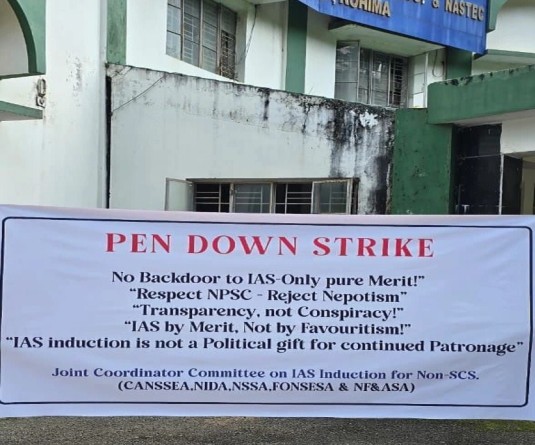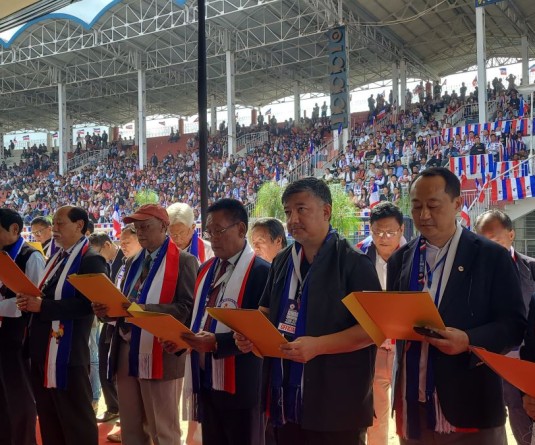(L-R) Keren Rose Koza, Assistant Manager, Media & Public Relations, NSDMA Joint CEO, Johnny Ruangmei & Nikantha Chaterjee, Chairman, IT & Communication. (Morung Photo)

Morung Express News
Kohima | May 10
The Nagaland State Disaster Management Authority (NSDMA) in partnership with OSCAR India (Open Source Classes for Amateur Radio India) has embarked on a ground-breaking initiative to respond effectively during crisis situations using amateur radio technology.
With the objective of establishing robust communication channels that remain accessible even in areas where conventional networks may be disrupted during disaster emergencies, a comprehensive mock drill exercise was conducted on May 9 at the no-network point in Dzüleke utilising Amateur Ham Radio Technology.
Briefing the media on May 10 at NSDMA Conference Hall, Joint CEO, Johnny Ruangmei highlighted about the Dzüleke mock drill wherein they enacted a scenario where tourists got lost in Dzukoü valley. Pointing out that in any eventualities, especially earthquake of bigger magnitude scales, even the strong network goes off, he said, radio talkie is made use of in such instances, but “another channel that is very reliable and resilient is the Amateur Ham Radio Technology.”
During the press conference, he also announced that NSDMA is one of the first state disaster management authorities in the country to have entered into the ham radio technology for emergency communication systems. In relation to this, a three-day hands-on training was also held for officers and staff of NSDMA from April 26-28 to enable them to acquire ham radio operator license, through an examination that will be conducted in the month of July. The CEO expressed hope that by September, the NSDMA will have licensed ham radio operators in the state.
In its press hand-out, the NSDMA also highlighted that “Amateur Radio, commonly known as Ham Radio, is both a popular hobby and a vital communication service that plays a crucial role in connecting people worldwide.” “Enthusiasts engage in ham radio to communicate across local neighborhoods, distant regions, and even outer space, using equipment and skills that don't rely on the internet or cellular networks”, it stated.
It further stated that this dynamic activity is not only fun and educational but also serves as a lifeline during emergencies when traditional GSM networks may fail. It was in recognition of the significance of amateur radio in disaster response that the NSDMA has teamed up with OSCAR India, an initiative of the All India School of Management and Information Technology (AISMIT), to conduct an innovative drill.
The partnership also aims at highlighting the resilience and effectiveness of amateur radio in providing reliable communication channels during times of need, showcasing its critical role beyond being just a hobby. It is further aimed at empowering communities and emergency responders with reliable tools to coordinate and respond effectively during crisis situations.
Referring to last year’s Nagaland emergency preparedness exercise during which state-wide mega mock drill was conducted, Johnny Ruangmei said, “We simulated earthquake and assumed that all the networks are down but we found it very difficult to connect with many of the districts.” This year, he stated hope that the ham radio technology will be used for the drill.
With radio being one of the oldest systems of communication, he said the ham technology uses the same wavelength to broadcast information to the communities, once they are also tuned in to the particular channel.
In the case of emergencies where everything goes off, he said, “What we are looking at is our licensed operators, who will use designated call signs issued by the Ministry of Telecom to broadcast.” “Any communities or village that has the old radio will be able to tune in to the channel and listen to us although they won’t be able to communicate to us,” he further highlighted.
However, licensed operators will be able to communicate to each other and with its use, district emergency operation centre can very easily communicate to the state emergency operation centre. Particularly in the case of any disaster, he underlined that through the OSCAR radio network, they would be able to activate all their radio operators, and information can also be relayed even outside the state.
Among those present at the press conference included Nikantha Chaterjee, Chairman, IT & Communication, All India School of Management & Technology Information and Keren Rose Koza, Assistant Manager, Media & Public Relations, NSDMA.






